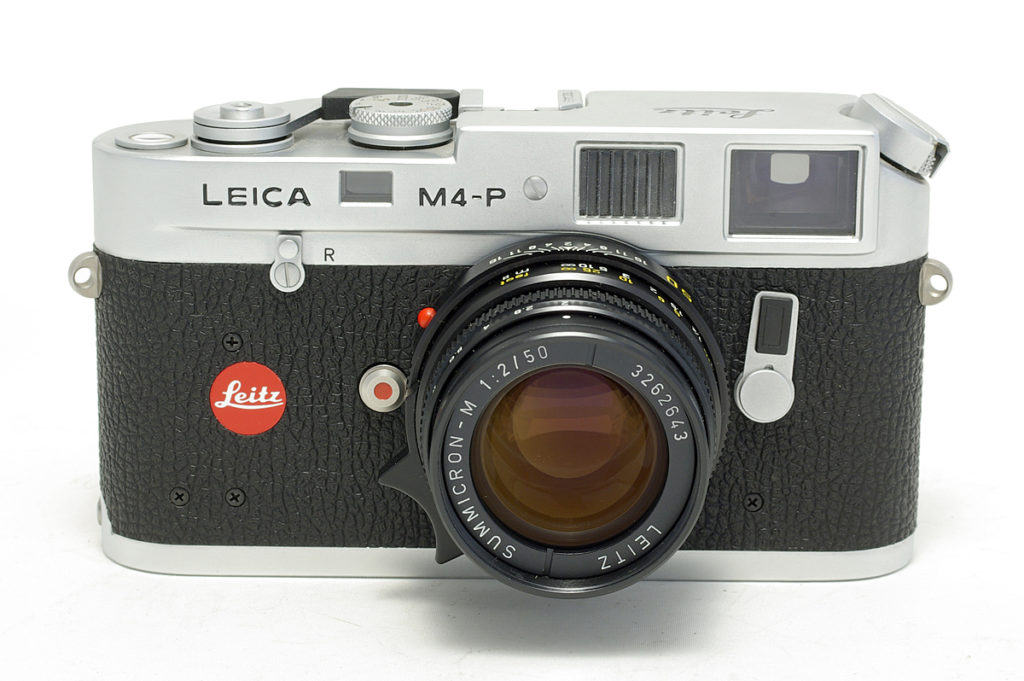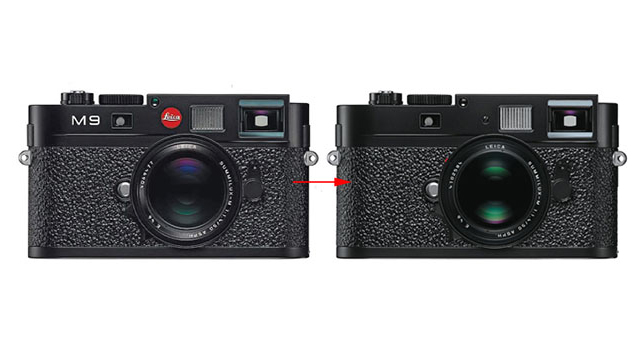
I’ll admit I don’t like the red dot. It’s tacky. When Leica was Leica, there was no red dot. I’m proud to say that, when I bought my first Leica, there was no such thing as a red dot. The red dot is post- Leica M5, the M5 being both the best and worst thing Leitz ever did. Best, because it’s the last and best version of a hand-assembled M, incorporating everything Leitz had learned about interchangeable lens rangefinder cameras up to that point and, in spite of what its detractors claim (invariably they’ve never used the M5), its a better, more complete camera than the film M’s – M4-2, M4-P, M6, M7 – that came after it, which were essentially retrenchments to a fixed formula. Worst, because Leitz confused a marketing failure with a technical failure and returned to the meterless M4 in M4-2 and M4-P versions, both of which signaled Leitz’s transition from producing professional cameras to models aimed at the consumer market. Hence, Leica’s slow inexorable slide into professional irrelevancy and the rise of internet-era clowns claiming the title “Leica Photographer.”

That’s One Ugly-Ass Red Dot IMHO
The ‘Leitz’ red dot goes back to the company’s Binocular and Microscope divisions, which
used the dot on their products for many years before someone decided to impale it on the hapless R3 and M4-P. Binoculars from the mid/late 60s have a rarer black ‘Leitz’ dot. As best I can tell, the Leitz red dot first appeared on the 50th Anniversary Leicaflex SL2 in 75 followed by the1976 R3. As for the M’s, it’s first seen on a preliminary 1977 run of a few hundred M4-2, and then into full production of the M4-P, which is, with its numerous top plate markings and huge Leitz red dot, the ugliest Leica M ever, although you can get rid of the red dot easily by replacing the vulcanite. Revisionist history aside, for late 70’s – early 80’s Leicaphiles, the red dot coincided with the end of the most desired models (M3, M2, M4, and M5) and represented a perceived decline in the quality for which Leicas had theretofore been known.
- 1980 black M4-P red dot
- 1983 chrome M4-P red dot
- 1987 R5, red dot moved to the right side
- R6, R7,RE, R6.2 red dot on the right
- M6 (1984) Leitz red dot on top center
- R8 (1996) Leica red dot moved to the left again
- M7 (2000) Leica red dot on top center
Leica’s final film camera, the MP (2003), thankfully did away with the red dot, although it’s been resurrected with the digital M’s and all the other assorted digital models they’ve produced. Why, I don’t know.
*************

Leica has learned to monetize the red dot and certain consumer’s aversion to it. Witness the M9-P upgrade, which allowed you pay $US1995 to upgrade your red dot m9 for a dotless M9-P. Granted, removal of a red dot alone didn’t cost two grand — Leica also replaced the LCD screen with sapphire glass (apparently a good thing they hadn’t bothered to use on the original M9), and threw in some new leatherette. They also got rid of the tacky M9 logo on the front plate. Gotta admit, the M9-P looks a lot better than the garden variety M9.

Views: 516

I paid £0.99 for a roll of black insulation tape.
You probably won’t like India
That red dot is very expensive too, unless you want to buy an expensively de-red-dotted facsimile, most without a dot, are under a grand, particularly pre-M.
What is more, they actually enhance the photographer’s enjoyment and perhaps even skill through regular use.
My experience of the red-dotted Leicas is that they are not so much an aid, they want to take over, and as Tim suggests above, they show the user how to do stuff correctly, which is not necessarily what photography is about.
The point is to not produce endless amounts of glossy prints, leave that to the iPhone. The point is to become one with your surroundings and really see stuff, even if many snapportunities are missed or fluffed.
Leica and Leica users are at odds with each other, the first wants to sell tools to professionals and wealthy dentists, whilst the second wants to hunt with the hounds.
I agree with you about the red dot. One the other hand, I beg to differ on the matter that the m5 is a better, more complete camera than the film …..M7 . The automatic Leica is a joy to use in the field. Might be not as pretty than the pre-M5 models, but refined and quick for the actual shooter. I have owned and use all the Ms, none of these do match the shooting convenience.
As for the dot, a piece of square black tape do the trick.
Yeah, the red dot should be verboten – never liked it.
That said, I’m stuck with two M6’s that blaze away.
Oh well, bring on the insulation tape?!
Greets, with hopes you & yours are, & remain healthy (& that you get out to make pix, at safe distance w/a mask) !
The only “red dot” I’ve ever considered was the M-mount lens alignment 😉 Sure, I placed some black tape on the M6 “Leica” red dot, then thought to myself: “Self, who really cares about branding?!” Form & function are why I use M cameras… plus rangefinder cams with primes, IMHO, amplify (simplify?) & engage in the process & vision, hopefully captured well!
What the exterior of the cam “looks like” is much less important than the internalized/captured result(s), for me… not a dentist (although recently difficult to secure an appointment :/ ). Okay, some pix may require post, yet it starts with with photog, camera & lenses as means, regardless a branding “dot.”
That written, agreed Leica was, & remains interested in monetizing a brand, & craft, “dot,” or no (cf recent M10M with obfuscated branding)… am thankful for the craft, dismissive of the branding exterior.
Happy snaps, & waking well
I had both the M6 and M7 and sold them because of the red dot…sort of. I found the red dots/LED’s too distracting (in the viewfinder.)
My M4-P needed a new skin and I had the red dot eliminated when YYe Camera re-covered the camera.
I don’t miss the dot, but I do miss walking about without a mask. The mask is not red.
The M4-P is not “really” a Leica M, Dan.
Wear the mask. Do you want to be mistaken for a science -denier?
Not Me! I believe in science. Mamma Castelli didn’t raise no fool!
As soon as I started reading this post a comment came to my mind, but the author himself made my point. Well before I could afford a Leica camera I became familiar with the red dot… on microscopes, as a student, then researcher (much more of an understatement on a one-meter high epifluorescence microscope than a pocket-size camera though…). Leica and the red dot were always indissociable for me, and I think I would miss it on my SL…
Branding is all around us – the F for Facebook to the take away coffee cup. Do you ask for a blank cup or carry a special roll of black tape to block out the Starbucks Logo (other coffee brands are available).
When I was a young photographer the Red Dot stood for quality, especially image quality. If I was a petrol head the Ferrari Horse may have been my iconic dream.
A question – if you took off the red dot or covered it in tape would the images it produces be any different? What it signifies for me is simplicity. Before I sold a few kidneys and bought my first M240 I tried the new Fuji cameras. Images were ok but when I took the camera out it had so many dials and buttons that it took me 30mins to remember where everything was. Picking up the M240 took me back to the mid 1970’s where I knew for 36 images what my ISO was and I just had to focus on Aperture and Exposure.
Whether the camera has a red dot on the front or doesn’t matters not a jot. Just revel in the joy of a well machined piece of equipment which allows you to focus on the image without loads of buttons and dials. After all when you use the camera you can’t see the Dot.
The problem with the red dot isn’t photographic: it’s cultural as well as aesthetic.
There are those fully aware that their camera cost a fortune, and either do not want to advertise to thieves in the street (that’s how my Rolex vanished; wisdom sometimes comes too late) or, perhaps, feel disinclined to project the image exactly because of its often negative connotations within the photographic community.
Either way, Leica sits in an interesting spot. As I have mentioned before, I am aware of the real differences that I remember seeing when printing my last employer’s M3 room-set negatives shot using a 21mm wide – not sure which one – and as I didn’t own it, there was no reason for me to feel any bias towards it one way or the other. But the reality was that when I left the man and went out on my own, even when things picked up for me, I did buy into Haselblad 500 Series cameras and Nikon F etc., but not Leica rangefinders which, like any other similar rangefinder camera, felt too restricted on so many practical levels, including that fabled claim of theirs about easy composition: try going for accurately placed OOF leaves, flowers or other objects between camera and model with a non-reflex camera, and that doesn’t always imply one is using long lenses. It is not always simply a matter of ability to purchase. But yep, it suits the snapshot mode of photography perfectly, though, which is not a put-down: check with early Magnum.
And what about the Leica R models? For 135 format photography they had one helluva flaw: they couldn’t offer 100% viewing. On a tiny original image that you hope to print without cropping, that is important.
I think that in the end, owning a current full-frame digital M of sorts would be very nice for those times when it fittted the purpose, but as a single camera on which to do all one’s photography, I don’t think so. Of course, no camera can pretend to offer that, but overall, an slr-type of camera is far more versatile.
Rob
One day, I must get better acquainted with spelling-checker devices: Haselblad?
I think my problem is using English in a computer put together for me in Spain: everything I write here appears underlined in red, and makes it incredibly difficult to read and edit, never mind write. Fortunately that doesn’t happen on the iPad too, but it offers its own problems.
Pity that this system here does not allow for previews before final posting; the T.O.P.’s site system does, and as far as I can remember, that stage does not show me the red underscore, but then it’s far better here, regardless of practical limitations. (Some may see that as Leica’s position…)
Oh well.